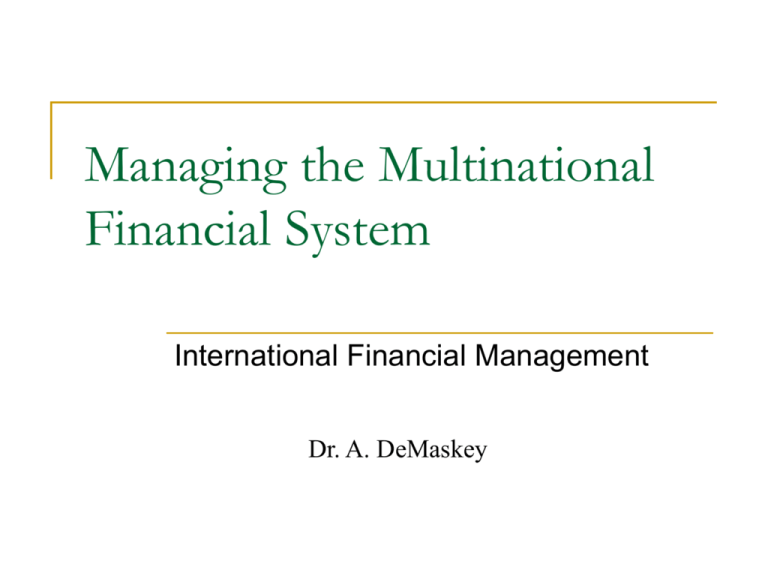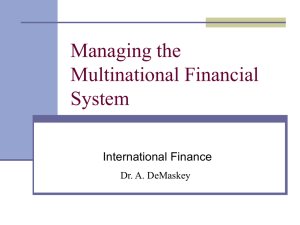Managing the Multinational Financial System
advertisement

Managing the Multinational Financial System International Financial Management Dr. A. DeMaskey Learning Objectives How do MNCs reposition their profits, cash flows, and capital within their multinational structures so as to maximize profitability, minimize global tax liability and optimize their use of capital? What are the fundamental methods for setting transfer prices between units of MNCs? What role do royalties and license fees play in the repositioning strategies employed by MNCs? How are dividend remittances determined? What is the role of leads and lags and reinvoicing centers to reposition funds and profits? The Multinational Corporate Financial System The MNC can control the mode and timing of internal financial transfers and thereby maximize global profits. Mode of Transfer Transfer pricing Timing Flexibility Leading and lagging The Value of the Multinational Financial System The ability to transfer funds and to reallocate profits internally presents MNCs with three different types of arbitrage opportunities: Tax arbitrage Financial market arbitrage Regulatory system arbitrage Constraints on Positioning of Funds Political Constraint Differential Tax Rates Transaction Costs Liquidity Requirements Intercompany Fund-Flow Mechanisms Unbundling Fund Transfers Transfer Pricing Payment of Fees Dividend Remittances Leading and lagging Unbundling of Fund Transfers Foreign Subsidiary’s Income Statement Sales Cost of goods sold Gross profit General & administrative expenses License fees Royalties Management fees Operating profit (EBITDA) Payment to Parent Company Payments to parent for goods or services Payments for technology, trademarks, copyrights, management or other shared services Depreciation & amortization Earnings before interest & taxes (EBIT) Foreign exchange gains (losses) Interest expenses Earnings before tax (EBT) Corporate income tax Net income (NI) Dividends Retained earnings Before-Tax in the Host Country Payments of interest to parent for intrafirm debt Distribution of dividends to parent After-Tax in the Host Country Transfer Pricing The pricing of goods and services transferred to a foreign subsidiary from an affiliated company is transfer pricing. The most important uses of transfer pricing include: Reducing taxes Reducing tariffs Reducing exchange rate risk Positioning of funds in locations to achieve various corporate objectives Disguising profitability Fund Positioning Effect A parent wishing to reposition funds out of or into a particular country can charge higher or lower prices on goods sold among subsidiaries. This will affect the income statement of the subsidiary and effectively raise or lower taxes. Note that the selling subsidiary will also have an opposite effect on its income statement. Tax Effects MNCs can minimize taxes by using transfer prices to shift profits from the high-tax to the low-tax nation. Set the transfer price as low as possible if TA > TB. Set the transfer price as high as possible if TA < TB. Transfer Pricing: Tax Effect Suppose Navistar’s Canadian subsidiary sells 1,500 trucks monthly to the French affiliate at a transfer price of $27,000 per unit. The Canadian and French tax rates on corporate income equal 45% and 50%, respectively. The transfer price can be set at any level between $25,000 and $30,000. At what transfer price will corporate taxes paid be minimized? Tariffs Ad-valorem import duty Levied on the invoice price of the imported goods. Raising the transfer price will thus increase the import duty. In general, the higher the ad-valorem tariff relative to the income tax differential, the more desirable it is to set a low transfer price. Transfer Pricing: Tariff Effect Suppose the French government imposes an ad-valorem tariff of 15% on imported trucks. How would this affect the optimal transfer pricing strategy, assuming that the ad-valorem tariff is paid by the French affiliate and is tax deductible? Constraints on Transfer Pricing The transfer pricing mechanism is constrained by: Tax regulations in the parent and host countries Working relationships with authorities in host countries Interest and goals of local joint venture partner Tax Provisions Section 482 of the U.S. IRS code Arm’s length transaction Methods of determining transfer prices: Comparable uncontrolled price Resale price Cost-plus price Others Reinvoicing Center Reinvoicing centers, located in tax havens, take title to goods and services used in intracorporate transactions. The physical flow of goods from purchasing units to receiving units is not changed. Basic purpose: Disguising profitability Avoiding government regulations Coordinating transfer pricing policy License and Royalty Fees and Overhead Charges License fees Royalty fees Management fees for general advice and expertise. Technical assistance fees for guidance on technical matters. License fees for use of patented products or processes. Overhead charges International Dividend Remittances Dividend payout policies have changed over the years and now incorporate several variables in determining the payout strategy. These variables are: Tax implications Political risk Foreign exchange risk Leading and Lagging Leading and lagging of interaffiliate payments is a common method of shifting liquidity from one unit to another. The value of leading and lagging is determined by the opportunity cost of funds to both the paying and receiving units. There is no formal debt obligation and no interest is charged up six months. Government regulations on intercompany credit terms are tight and can change quickly. Leading and Lagging: Illustration A U.S. parent owes its British affiliate $5 million. The timing of this payment can be changed by up to 90 days in either direction. The U.S. lending and borrowing rates are 3.2% and 4.0%, respectively. The U.K. lending and borrowing rates are 3.0% and 3.6%, respectively. If the U.S. parent is borrowing funds and the British affiliate has excess funds, should the parent speed up or slow down its payment to the U.K.? What is the net effect of the optimal payment activities in terms of changing the units’ borrowing costs and/or interest income?




